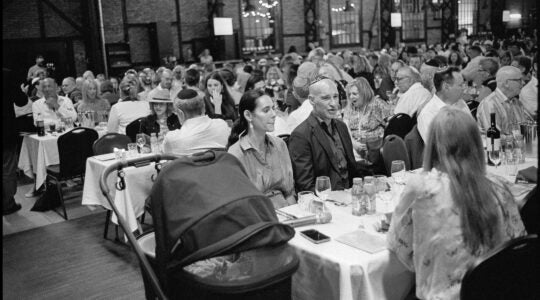As much a culinary anthropologist as a food writer, London-based Claudia Roden has been writing about food, and its history, for nearly half a century. Her articles and books (including her James Beard Award-winning magnum opus, “The Book of Jewish Food: an Odyssey from Samarkand to New York,” 1996) are written in a conversational style, but they display a depth of scholarly research as she tries to uncover the history and origins of the dishes she describes.
The Egyptian-born Roden, who grew up in Cairo, moved to London in the early 1950s to study painting at the St. Martin School of Art. But it was a few years later, after the 1956 Suez crises started a mass emigration of Egyptian Jews, that Roden found her true calling. “All the recipes I got in my first book,” she said, referring to 1968’s “A Book of Middle Eastern Food,” “started with all the Jews who came out of Egypt in 1956. They were staying in London, or stopping in London, and moving on to different countries, when they were thrown out of Egypt.”
Roden explains that in Egypt nobody would share family recipes, “but suddenly everybody was exchanging recipes and saying, ‘I might never see you again, but here’s my recipe so that you remember me.’ … I started researching it [the book] gradually. [At first] I didn’t think I was doing a book; I was just collecting our heritage, for us.”
“Egypt in my time was a cosmopolitan, multi-cultural world,” says Roden. “Syrians, Christians, Greeks, Armenians, Italians and English expatriates were in Egypt, and we were living amongst the Muslims; they all spoke many languages, but French was the common language. The food was also a cosmopolitan mix. The haute cuisine of Egypt, which we also inherited, was from the local aristocracy, which was Ottoman-Turkish. So we had some Ottoman dishes, but the Jewish community in Egypt was itself a mosaic of people who came from all over the Ottoman world when the Suez Canal was built.”
When asked about her childhood Passovers in Egypt, Roden’s memories were of “a long, long table [that extended into] two rooms, doors opening into the dining room and living room. The grownups were all on one side of the table, and the children were on the other. … It [the seder] went on and on. It was in French because we spoke French, but the men sang in Hebrew. (The girls, [including] myself, never had Jewish [education] while in Egypt.) My father or my grandfather would tell the story of the flight from Egypt, and so for us it was very funny because we were still in Egypt, and we thought we were those who had been left behind. … One of the happiest times of my time in Egypt were the festivals, and in particular Passover.”
Roden does not see herself as any sort of an expert on wine; nor did wine play a big role in her native Egyptian-Jewish cookery. “In the Muslim world wine was not used, and we were Arab Jews, so wine was not usual. … But we did use it [wine] for desserts,” she says.
The Jews who have mastered wine cookery are those of France, she added. “It’s Ashkenazi food. In Alsace, there is a goose that is cooked with cognac or calvados. They also have chicken livers that they sauté with calvados or cognac. I found that dishes that originally came from Moscow, grander dishes, were cooked in wine. … In France there is a recipe called Carpe à la Juive, which is Russian style. It’s jellied carp in white wine.”
Passover Recipes from Claudia Roden
For Passover in Egypt we made Roz ou Hamud with Kobeba Hamda — ground rice dumplings stuffed with minced beef and poached in a lemony chicken soup with leeks, celery and courgettes [zucchini] — which we served over rice. We also made artichoke hearts with broad beans. Many Sephardi communities eat broad beans during Passover because they were eaten by the Israelites in Egypt. Vendors came to our kitchen door to sell artichokes by the crate. In the UK, I use frozen artichoke bottoms from Egypt and peeled broad beans from Iran that I find in Middle Eastern stores. We made breast of lamb stuffed with spicy rice with fried onions, ground beef, pine nuts and raisins, in an apricot sauce. In the UK, we started making easier meat dishes. In the Sephardi world, celebratory meat dishes were often sweet with fruits such as apricots, prunes, quinces and raisins. Almond cakes were a Passover specialty.
Agneau Aux Raisins Secs Et Aux Amandes Lamb with Raisins and Almonds
This is a Passover speciality of Fez and Meknez in Morocco that is easy to make. As usual on festive occasions in Morocco, meat dishes are sweetened with honey, but I add only a touch. Start with a tiny bit of honey, as it may not be to your taste and add more if you like.
Serves 8
1 pound small pickling onions, peeled
5 tbsp. groundnut or light vegetable oil
2 lbs. lamb, shoulder or fillet of neck, cubed and trimmed of some excess, but not all, fat
Salt and pepper
1/4 tsp. saffron threads (optional)
3/4 tsp. ground ginger
1 2/3 cups seedless raisins
1 tsp. cinnamon
1-3 tbsp. honey (optional)
2/3 cup blanched almonds
Put the onions in a large pan with 3 tablespoons of oil and the meat, and sauté, stirring, until the meat changes color. Add salt and pepper, saffron (if using) and ginger. Cover with water and simmer for 1 1/2 hours or until the meat is tender. Add the raisins and cinnamon and cook another 15 minutes. Add the honey (if using) and cook 15 minutes more.
Lightly fry the almonds in the remaining oil, until slightly colored, chop them coarsely or leave them whole. Serve hot with the almonds sprinkled on top.
Gateau Au Syrop D’Orange Almond Cake in Orange Syrup
This is a wonderful Judeo-Spanish cake. Make it at least a few hours before you are ready to serve or the day before so that the juice has time to soak in.
Serves 12 -14
8 eggs, separated
1 cup sugar
The grated zest of 1 orange
1 cup ground almonds
½ cup blanched almonds very finely chopped
For the syrup
1 pint freshly squeezed orange juice
1 cup sugar
Mix well the egg yolks with the sugar, orange zest, and all the almonds. Beat the egg whites until stiff and fold them in. Pour into an oiled and floured 10-inch cake pan and bake at 350ºF for about 1 hour.
Make a syrup by bringing to a boil the orange juice with the remaining cup of sugar. Take it off the heat and stir to dissolve the sugar.
When the cake has cooled, turn it out onto a deep serving dish that will hold the cake and the syrup. Make little holes on the top with a fork to allow the juices to be absorbed and pour the syrup on top. Or cut it into serving pieces (so that they can better absorb the juice) and pour the syrup over them. Leave to soak for a several hours or overnight. A nice way to serve this cake is with orange slices.
Haroset
We believed our haroset was the best because it was the color of the Nile silt, which the Hebrew slaves used to make the mortar to build the pyramids.
9 oz. pitted dates, chopped
4 oz. raisins or sultanas
2/3 cup sweet red Passover wine
2 oz. walnuts, coarsely chopped
Put the dates and raisins or sultanas with the wine in a pan and barely cover with water. Cook, covered, over very low heat, stirring occasionally until the dates fall apart into a mush, adding a little water if it is too dry. Cook until it becomes a soft paste. You can blend it in a food processor. Pour into a bowl and sprinkle with walnuts.
Carpe a la Juive Russian style Jellied Carp
Poached carp served cold in its own jelly is one of the classics of Eastern European Jewish cookery. It is featured in Russian and Polish cookbooks as “in the Jewish Style.” A Polish version is sweet with added sugar. This Russian one, with white wine, is how it is made in Paris.
Serves 6
1 large carp weighing about 3 ¼ pounds
2 medium onions, cut in half then sliced
2 1/2 cups medium dry white wine
The thinly pared peel of 1 lemon
2 bay leaves
1 sprig of thyme
A few parsley stalks
Salt and pepper
Have the carp cleaned and cut in thick steaks. Put the onions at the bottom of a pan. Place the fish steaks and the head on top. Pour in the wine, then add the same amount of water and the rest of the ingredients. Bring to the boil, remove the scum, then simmer very gently, covered, on the lowest possible heat for 1 1/2-2 hours until the fish is tender. Lift the slices and the head out, and arrange in a serving dish. Reduce the stock if necessary by simmering, uncovered, and strain over the fish. Cool and refrigerate, covered with plastic film. A rich firm jelly will form.
Variations:
– Garlic, allspice and bouquet garni can be part of the aromatics.
– Garnish, if you like with chopped pickled cucumbers.
Gamliel Kronemer writes the Fruit of the Vine kosher wine column for The Jewish Week.
The New York Jewish Week brings you the stories behind the headlines, keeping you connected to Jewish life in New York. Help sustain the reporting you trust by donating today.




